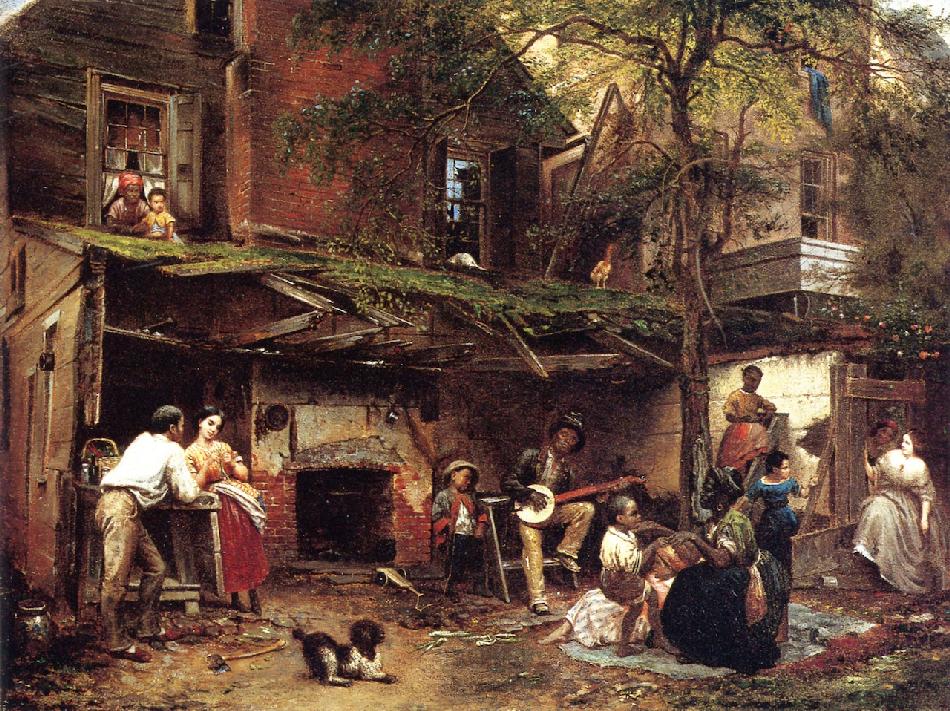
American Slavery: The Border States

Figure 1.--This painting by Eastman Johnson (1824-1909) depicts urban slave life in the Border States, a far cry from the situation of field hands in the Deep South. This is interesting because unlike many depictions of slavery, it us not a propaganda piece, but a realistic depiction and a piece of art. Johnson had abolitionist leanings, but was admired for his realistic genre work depicting every day life, mostly in the Civil War an post-Civil War era. Johnson was an imprtant American artist and co-founder of the Metropolitan Museum of Art in New York City. He also did portaits of important Americans, including President Lincoln. He was known as The American Rembrandt. Johnson studied in Europe and returned to the United States because of the death of his mother. He then spent afew years in the West. Then he returned to the East Coast (1858) and established a studio in New York City. He immediately secured his reputation as an important American artist with an exhibit at the National Academy of Design (1859). His most important work shown was 'Negro Life at the South', commonly called 'Old Kentucky Home'. It was set in the urban back yards of Washington, D.C. where his family lived for some time.
|
|
The nature of slavery varied dramtically in the 15 slave states at the time of the Civil War. The popular image is that of the plantation slaves in the Deep South (Cotton States) This is not unreasonable in that this is wear most Americam slaves were held, something like half of American slaves. And here about half the population was slaves. But even here not all the slaves were plantation hands. There were slaves in the cities that filled a wide range of roles. The vast majority were, however, field hands, This was all very different in the four Border States (Deleware, Maryland, Kenticky, and Missouri). Here slaves were a much smaller portion of the population. The highest proportion was in Kentucky (about 20 percent) and in Maryland and Missouri (about 10 percent). The slave population in Delware was insignificant. And unlike the rest of the South, there were many free blacks in both Delware and Maryland. Througout the Border States slavery was dying out in the urban areas. And the slaves in the border states had many occupations and were not mostly fiekd hands as was the case in Deep South. They were more likely to have occupations more similar to the whute population, at least the working class. In addition, geography placed limits on the ability of slave owners ti mistraet their slaves. Running away was not a realistic proposition for the field hands of the Deep South. This was different matter for slaves in the Border States. The vast portion of the runaways traveling the Underground Railway camne from the Border States. As slavery w decling in the border states, some slave holders began selling their slaves as there was still a strong demand for field hands in the Deep South--hence the term 'sold down the river'. There were also divisions within the Border States. Maryland was in particular divided betwen the pro-slavery east and anti-salvery more mountaneous west. (The neighboring area of Virginia, suceeded from Virginia during the Civil War becoming West Virginia.) The Border States had extensive economic ties to the North, and not just cotton as was the case of the Deep South. although were closer to the South culturally. As a result, as the United States moved toward Civil War, the Border States were split. And unlike the Deep South, slavery was not the burning issue and constitutiinality and states rights were more important. The substantial white population and the strategic position made the border states the key to victory. President Lincoln understood this, stating famously, "I hope to have God on my side, but I must have Kentucky." As a result, Lincoln held back and did not launch the War. President Davis did not and ordered Confederate forces in Charleston to fire on the Federal forces in Fort Sumter.
CIH

Navigate the Children in History Website:
[Return to Main American slavery page]
[Return to Main American debate over slasvery]
[Return to the Main Civil War page]
[About Us]
[Introduction]
[Biographies]
[Chronology]
[Climatology]
[Clothing]
[Disease and Health]
[Economics]
[Geography]
[History]
[Human Nature]
[Law]
[Nationalism]
[Presidents]
[Religion]
[Royalty]
[Science]
[Social Class]
[Bibliographies]
[Contributions]
[FAQs]
[Glossaries]
[Images]
[Links]
[Registration]
[Tools]
[Children in History Home]
Created: 7:38 AM 5/18/2015
Last updated: 7:38 AM 5/18/2015



